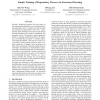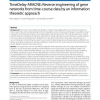120 search results - page 11 / 24 » How Much Can We Gain from Supervised Word Alignment |
NIPS
2007
13 years 11 months ago
2007
In transfer learning we aim to solve new problems using fewer examples using information gained from solving related problems. Transfer learning has been successful in practice, a...
IJCAI
2007
13 years 11 months ago
2007
Recently, significant progress has been made on learning structured predictors via coordinated training algorithms such as conditional random fields and maximum margin Markov ne...
IVS
2007
13 years 10 months ago
2007
A semantic substrate is a spatial template for a network, where nodes are grouped into regions and laid out within each region according to one or more node attributes. This paper...
FLAIRS
2007
14 years 21 days ago
2007
The linguistic theory of Applicative and Cognitive Grammar analyses the language in three levels as follows: the linguistic level, the predicative level, and the semanticocognitiv...
BMCBI
2010
13 years 10 months ago
2010
Background: One of main aims of Molecular Biology is the gain of knowledge about how molecular components interact each other and to understand gene function regulations. Using mi...


